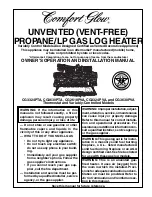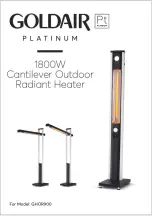
2
Mechanical Instructions
Site Selection
Review the NEMA Type rating of the heater noted on the
INDEECO Application Data. Do not install a heater in an
area not consistent with its rating.
Allow sufficient free space around heater installation site.
Work space for heater maintenance should be at least three
feet in front and on either side of the heater. The minimum
pull space for the Immersion Heater installation or removal
from the vessel should be at least equal to length between
the inlet and outlet nozzle plus two feet.
Electric heaters are capable of developing high
temperatures. Therefore, extreme care should be taken to
avoid mounting heaters in an atmosphere containing
combustible gases, vapors, dusts, or fibers unless properly
marked as suitable for the condition.
Heater Orientation
This heater has been constructed for a specific mounting
orientation. It must be mounted in this manner, to prevent
improper operation or damage. Refer to the INDEECO
Application Data for the correct mounting figure number.
The location selected must be capable of safely supporting
the heater’s weight plus the fluid weight.
Mount the heater with structural quality bolts matching the
holes provided in the mounting feet. When Figure 23
(Vertical Floor Mounting) is provided, the mounting
channels must be drilled by the user. Where slotted holes
are provided, install the bolts to the outside of the slots to
allow the heater to thermally expand. Mount on a smooth
surface. Do not use lock washers, and apply minimum
torque necessary to contain the equipment but not prevent
expansion on bolts in slotted holes.
The heater should be mounted plumb horizontally and
vertically to assure proper flow and avoid draining or venting
problems.
Pipe the incoming fluid connection to the nipple marked
"Inlet". Pipe the hot outgoing connection from the nipple
marked "Outlet". The inlet and outlet references on the
attached figures are shown as the INDEECO standard
arrangement. The actual markings on the heater may be
reversed. Do not operate the heater with a flow direction
different from the nozzle markings without approval from
INDEECO. The heater may include instruments that will not
operate properly if the flow direction is reversed.
Note that customer piping must be supported to minimize
nozzle loading on the heater inlet and outlet. Consider
using expansion joints or flex hoses to allow connections at
the slotted end of the heater to move with the heater.
Failure to do so may result in damage or leaking of the
heater vessel.
Thermal expansion of the heater can be approximated as:
Nozzle to
Nozzle length
(Inches)
x .00001 x
Operating
Temp (
q
F)
- 70
q
F
With liquid systems, the customer piping must be routed
and piped to ensure proper venting of the heater. Trapped
pockets of air will result in improper operation and potential
heater damage. High points must be vented and low points
drained to allow equipment maintenance. A low point drain
plug is provided in the heater to allow draining.
The heater is designed for operation at specified design
flows. When flow rates are not defined, the general
requirement is to limit flow velocity to 10ft/sec for liquids or
keep the density (#/ft
3
) x velocity (ft/sec) <10,000 for gases.
Customer piping size should match the inlet/outlet of the
heater to meet this requirement unless otherwise noted.
If the heater is installed in a pressurized system, a relief
valve must be installed at the outlet of the heater. A
pressure relief valve may be sufficient, unless local codes
require a pressure-temperature relief valve. As a minimum,
the valve must be sized to relieve at a rate equal to the rate
that the heater can thermally expand fluid trapped in the
heater due to downstream blockage.
DO NOT place a shutoff of any type between the pressure
relief valve and the heater, or on discharge pipes between
the relief valve and the atmosphere.
On heaters with ANSI flanged inlet/outlets, take care to
prevent scratching the flange faces. Select a gasket rated
for the application service and temperature and pressure.
Clean and flush system prior to initial startup to remove
contamination generated during fabrication. Provide filters
or strainers on liquid systems as required.
Insulation
Insulation is typically provided only on the heater shell by
INDEECO. The customer may prefer to add additional
insulation to the Immersion Heater flange or bottom head of
the vessel for added personnel safety and energy
conservation.
Insulation used on heating systems with flammable liquids
should utilize closed cell insulation to reduce fire hazards
caused by absorption of leaks.
WARNING
On heaters with extended terminal boxes and exposed
element tubes, do not insulate more than 2” above the
Immersion Heater flange. Dangerous over-heating of
the terminal box wiring could result.
WARNING
Some surfaces of the heater vessel or Immersion
Heater may be extremely hot. Avoid contact to prevent
personnel injury or fire.
























